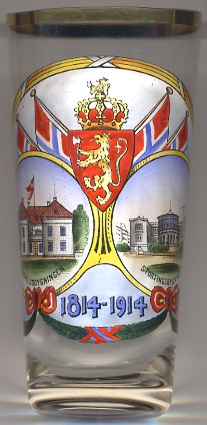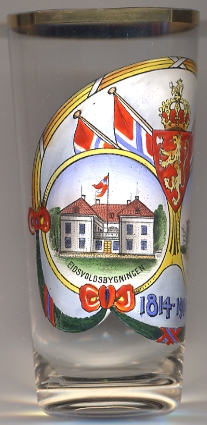

|
| NORGE / NOREG | NORWAY |
| fylke: Akershus | county: Akershus |
 Eidsvoll (until 1918 Eidsvold) is situated at an elevation of 159 m in the north of Akershus county in southern Norway, about 70 km northeast of Norway's capital,
Oslo. The municipality of Eidsvoll has a population of about 22,200 (2013).
Eidsvoll (until 1918 Eidsvold) is situated at an elevation of 159 m in the north of Akershus county in southern Norway, about 70 km northeast of Norway's capital,
Oslo. The municipality of Eidsvoll has a population of about 22,200 (2013).
Eidsvoll is already mentioned in Old Norse manuscripts. In the 11th century, it became the site of court and assembly (ting) for eastern parts of Norway, replacing Vang, now a part of Hamar in Hedmark. The eastern parts of Eidsvoll were for a short time the site of a minor gold rush when gold was found in 1758, and these areas are still known as Gullverket, (the Gold works). Eidsvoll Verk was opened to smelt iron ore by King Christian IV of Denmark and Norway in 1624, relying on the excellent water power from the Andelva river. InIn 1688, it was owned by the director of the Kongsberg Silver Mines, Schlanbusch, and remained in his family until 1781. Carsten Anker came into possession of works in 1794, at which time it was in decay since many of the surrounding forests required for charcoal had been depleted. He restored it and set up the production of stoves and similar iron goods. He also took residence in Eidsvoll in 1811, rebuilding the house which is now the Eidsvollsbygningen (see below). Since 1380, Norway had been in a personal union with Denmark, ruled by the Danish kings. In 1814, after the Napoleonic wars, the Peace of Kiel stipulated that Denmark, because of its support for France, had to cede Norway to Sweden. However, Norway at first resisted this decision and adopted a new constitution. Eidsvoll was the site where the constitutional assembly met to draft and sign the constitution of Norway on 17 May 1814. Until recently, the main industry of Eidsvoll was agriculture, though the soil is rich in clay. In 1854, Eidsvoll became the end point for the first railroad line in Norway from Oslo. This became the transit point for travel with the paddle steamship Skibladner on Lake Mjøsa to Hamar, Gjøvik, and Lillehammer.
 The
The  Eidsvollsbygningen [bottom left picture on glass no. 2844]
was first constructed in 1770. Around 1800 Carsten Anker bought the building, he renovated it and he and his family lived there when the Constitution was signed.
The building today is a famous museum.
Carsten Anker went bankrupt in 1822 and the estate was sold at auction in 1823.
The building was renovated in 1895 and in 1964. A new renovation and restoration started in 2011. The project is to be completed for the 200 year Jubilee of the Constitution in 2014.
Eidsvollsbygningen [bottom left picture on glass no. 2844]
was first constructed in 1770. Around 1800 Carsten Anker bought the building, he renovated it and he and his family lived there when the Constitution was signed.
The building today is a famous museum.
Carsten Anker went bankrupt in 1822 and the estate was sold at auction in 1823.
The building was renovated in 1895 and in 1964. A new renovation and restoration started in 2011. The project is to be completed for the 200 year Jubilee of the Constitution in 2014.
Glass no. 2844 is a souvenir from the 100th anniversary of the Norwegian constitution and thus bears the dates 1814 and 1914. The second picture on the glass shows a view of the Stortingsbygningen (Parliament Building) in Oslo.
The coat of arms and the crown refer to King Haakon VII, the first Norwegian king after the country
had gained its independence from Sweden in a referendum in 1905. Haakon was born Prince Carl of Denmark from the House of
Schleswig-Holstein-Sonderburg-Glücksburg,
second son of Crown Prince Frederik of Denmark,
and thus was one of the few elected monarchs of Europe. He also thus became a monarch both before his father (1906 Frederik VIII of Denmark) and his elder brother (1912
Christian X of Denmark). By chosing the new name Haakon, the king refered to Haakon VI Magnusson, king of Norway from 1343 until his death in 1380 and king of Sweden between
1362 and 1364 (co-ruling with his father, Magnus IV (VII of Norway), until they were both deposed by a Swedish rebellion).
[http://en.wikipedia.org/wiki/Eidsvoll, https://de.wikipedia.org/wiki/Eidsvoll, http://en.wikipedia.org/wiki/Eidsvollsbygningen,
http://en.wikipedia.org/wiki/Norwegen, https://de.wikipedia.org/wiki/Norwegen,
http://en.wikipedia.org/wiki/Haakon_VII_of_Norway]
![[scale]](lineal.jpg)